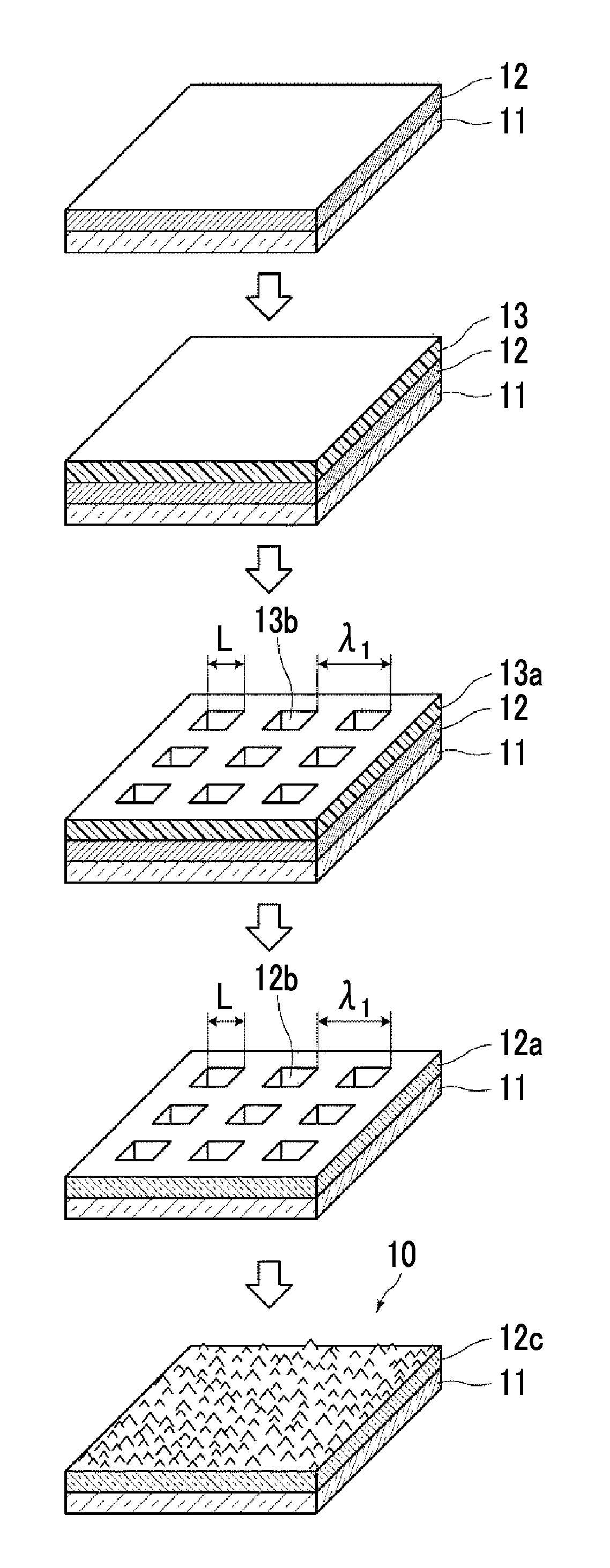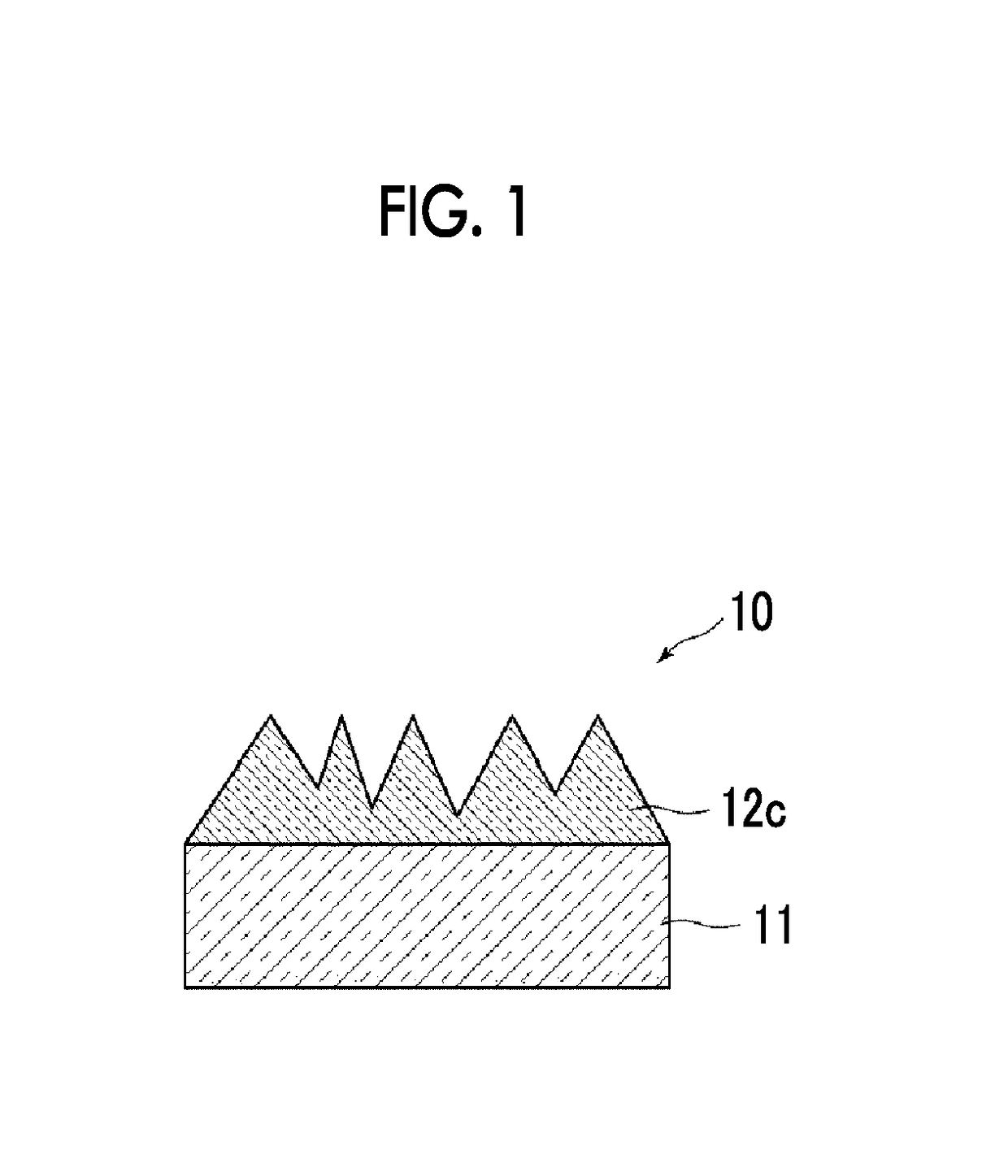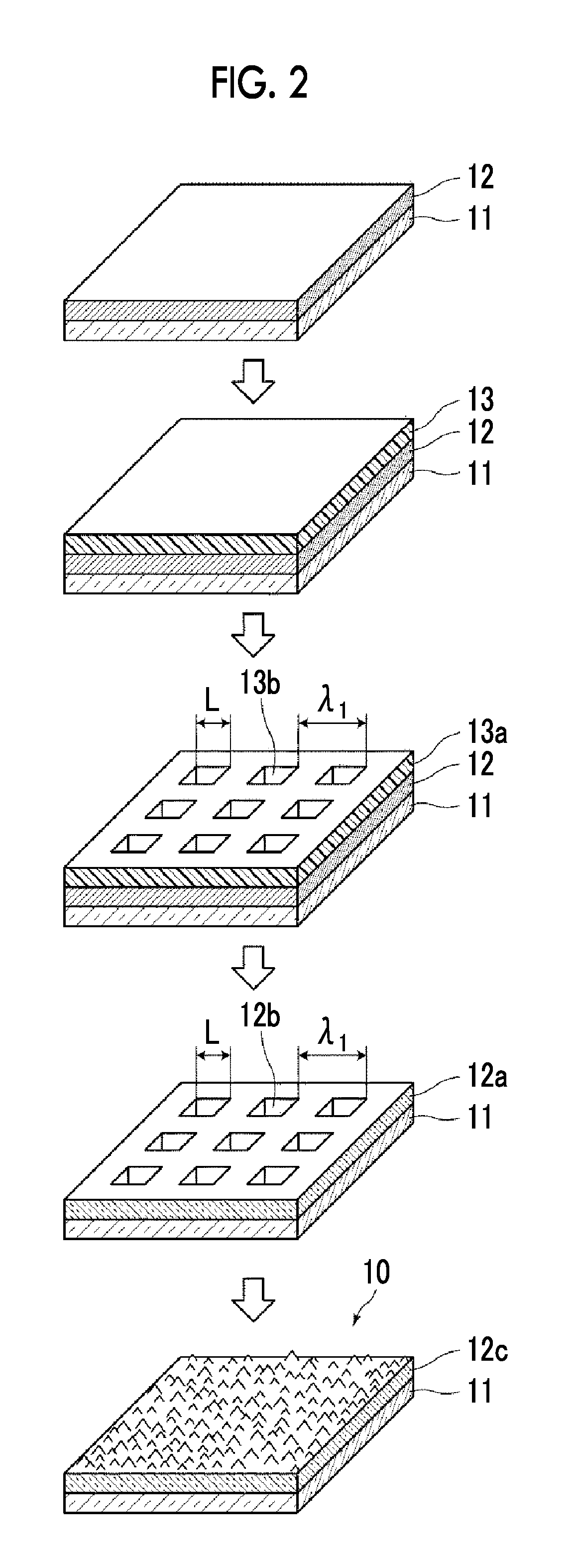Method of manufacturing structure
a manufacturing method and structure technology, applied in the field of manufacturing structures, can solve problems such as setting the conditions for applying structures, and achieve the effect of satisfying anti-reflection performance and great effect on the quality of optical elements
- Summary
- Abstract
- Description
- Claims
- Application Information
AI Technical Summary
Benefits of technology
Problems solved by technology
Method used
Image
Examples
example 1
[0107]Hereinafter, the manufacturing method in a case in which the structure of the present invention is an optical member will be described.
[0108](First Step)
[0109]First, synthetic quartz glass (product name “AQ”, manufactured by Asahi Glass Co., Ltd.) which is a transparent substrate was used as the substrate. On the transparent substrate, a thin alumina (Al2O3) film was formed as the precursor film by electron cyclotron resonance sputtering (ECR) (device name “AFTEX-6000”, manufactured by JSW AFTY Corporation) to have a thickness of 80 nm.
[0110](Second Step)
[0111]Next, a resist film for electron beams (product name “FEP-171”, manufactured by Fujifilm Electronic Materials Co., Ltd.) was applied onto the thin alumina film.
[0112]On the entire surface of the resist film for electron beams, a periodic pattern having square openings in which a length of one side is 100 nm arranged at an interval of 200 nm period was drawn by an electronic beam. Then, the resist film was developed to ob...
example 2
[0121]Example 2 shows a manufacturing method in a case in which the structure is an optical member and a fine uneven structure is formed by using an Ag-deposited mask.
[0122](First Step)
[0123]First, synthetic quartz glass (product name “AQ”, manufactured by Asahi Glass Co., Ltd.) which is a transparent substrate was used as the substrate. On the transparent substrate, a thin alumina (Al2O3) film was formed as the precursor film by electron cyclotron resonance sputtering (ECR) (device name “AFTEX-6000”, manufactured by JSW AFTY Corporation) to have a thickness of 80 nm.
[0124](Second Step)
[0125]Next, Ag was deposited onto the thin alumina film by electron beam (EB) deposition (device name “EVD-1501”, manufactured by CANON ANELVA CORPORATION) so as to have a target film thickness of 5 nm. Through self-organization of Ag, Ag particles having a diameter of about 20 to 60 nm were formed over the entire surface of the thin alumina film in a state in which a large number of particles were fo...
example 3
[0130]Example 3 shows a manufacturing method in a case in which the structure is an optical member and a fine uneven structure is subjected to plasma etching without using a mask.
[0131](First Step)
[0132]First, synthetic quartz glass (product name “AQ”, manufactured by Asahi Glass Co., Ltd.) which is a transparent substrate was used as the substrate. On the transparent substrate, a thin alumina (Al2O3) film was formed as the precursor film by electron cyclotron resonance sputtering (ECR) (device name “AFTEX-6000”, manufactured by JSW AFTY Corporation) to have a thickness of 80 nm.
[0133](Second Step)
[0134]Subsequently, the thin alumina film was subjected to plasma etching (device name “NE-500”, manufactured by CANON ANELVA CORPORATION) for 50 seconds. For the etching conditions, the process pressure was set to 1.0 Pa, the etching gas was set to CHF3 / Ar=5 / 25, and the radio frequency (RF) output (Ant / Bias) was set to 700 / 50 W. The thin alumina film was etched to a depth film thickness o...
PUM
| Property | Measurement | Unit |
|---|---|---|
| acceleration voltage | aaaaa | aaaaa |
| wavelength range | aaaaa | aaaaa |
| wavelength range | aaaaa | aaaaa |
Abstract
Description
Claims
Application Information
 Login to View More
Login to View More - R&D
- Intellectual Property
- Life Sciences
- Materials
- Tech Scout
- Unparalleled Data Quality
- Higher Quality Content
- 60% Fewer Hallucinations
Browse by: Latest US Patents, China's latest patents, Technical Efficacy Thesaurus, Application Domain, Technology Topic, Popular Technical Reports.
© 2025 PatSnap. All rights reserved.Legal|Privacy policy|Modern Slavery Act Transparency Statement|Sitemap|About US| Contact US: help@patsnap.com



